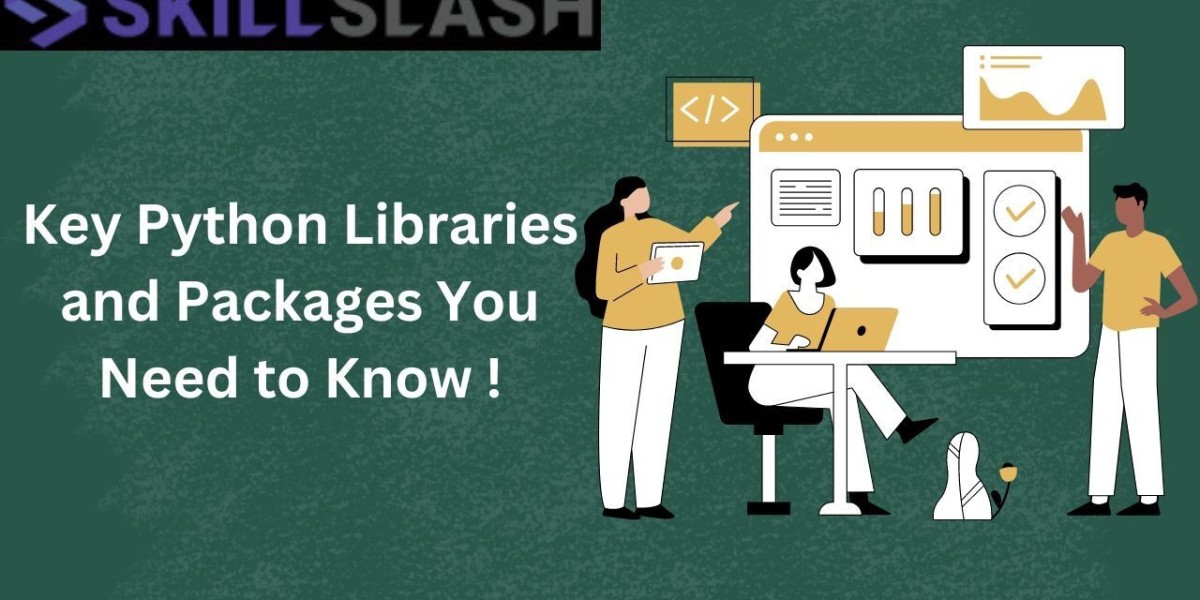Python is one of the most popular programming languages in the world today, and it’s easy to see why. It’s simple, flexible, and has an ever-expanding library and package ecosystem, making it the preferred language of developers and data scientists, as well as engineers. Python’s ability to seamlessly integrate with a wide range of libraries has become its hallmark. From data manipulation and visualization to machine learning and web development, Python’s rich ecosystem has you covered.
Whether you’re just getting started with Python, or an experienced coder who’s looking to broaden your knowledge, this article provides you with a step by-step guide to discovering the top Python libraries and packages that can help boost your projects.
What are Python Libraries and Packages ?
Libraries and packages are important parts of the Python programming language that help extend its features and make the development process easier.
Libraries are a collection of pre-written modules and functions that can be used to do a bunch of different things, like math, data manipulation, web development, etc. These libraries save time and effort by giving you a ready-made solution for common problems.
Packages, on the other hand, are a way to organize related libraries and modules into a structured directory hierarchy. They help manage the distribution, installation, and organization of Python code. A package is essentially a directory containing Python scripts (modules) and a special file called __init__.py, which tells Python that the directory should be treated as a package.
5 Key Python Libraries and Packages
Python is a programming language that can be used for a wide range of purposes and applications. It has a large library and package ecosystem that can be used in a variety of ways.
Here are five of the most important python libraries and packages you need to know, based on your area of expertise :
NumPy (Numerical Python) :
NumPy, short for “Numerical Python” is a fundamental Python library that provides fundamental tools for numerical operations and manipulating arrays and matrices in Python. Numerical Python is the foundation of data science and scientific computing, as well as numerical analysis. It is especially powerful because it provides powerful data structures for large data sets and a set of mathematical functions to deal with these arrays.
At the core of the Python programming language, there is a built-in data structure called “numpy.ndarray” also known as “numpy” array. Numpy arrays are very similar to the Python lists, but they perform numerical operations more efficiently and can work with more than one dimension of data. Numpy arrays enable you to do element-based operations, perform mathematical functions, perform advanced slicing operations, and perform indexing operations.
Here is an example of using NumPy to construct an array and execute some basic operations :
[ import numpy as np # Import the NumPy library and alias it as 'np'
# Create a NumPy array from a Python list
my_list = [1, 2, 3, 4, 5]
my_array = np.array(my_list)
# Perform operations on the array
squared_array = my_array ** 2 # Square each element of the array
sum_of_elements = np.sum(my_array) # Calculate the sum of all elements
# Access specific elements using indexing
element_at_index_2 = my_array[2] # Access the element at index 2 (zero-based indexing)
# You can also create multi-dimensional arrays
matrix = np.array([[1, 2, 3], [4, 5, 6]])
# Perform operations on multi-dimensional arrays
transpose_matrix = np.transpose(matrix) # Transpose the matrix ]
In the example above, we have imported the NumPy library as np. This is a well-known convention. Then, we are going to create a Python array from the list. We are going to perform operations such as squaring, summing, and indexing to access specific elements. All of these operations are easy to do with the help of the NumPy library. Furthermore, it is optimized for numerical calculations, making it an essential library for many scientific and data related tasks in Python.
Pandas
Pandas is a powerful Python library for manipulating and analyzing structured data. It offers an intuitive and flexible approach to working with structured data that is easy to use by both novice and seasoned data scientists alike. Pandas introduces two fundamental data structures: DataFrame and Series. A DataFrame is a data structure that is similar to a spreadsheet to a database table. It consists of rows and columns of data, each of which can have a different data type. On the other hand, a Series is a single line data structure. It looks like a list or an array but it has more powerful features.
Pandas make it easy to do all the stuff you need to do with your data - like loading it from different formats like CSV, Excel and SQL, cleaning and transforming it, finding any missing information, and even organizing, grouping, and merging it all.
Here’s a quick example of how you can use Pandas to look at a CSV file :
[ import pandas as pd
# Load data from a CSV file into a DataFrame
data = pd.read_csv('data.csv')
# Display the first few rows of the DataFrame
print(data.head())
# Get basic statistics about the data
print(data.describe())
# Select a specific column
column = data['column_name']
# Filter data based on a condition
filtered_data = data[data['column_name'] > 50]
# Group data by a categorical variable and calculate mean values
grouped_data = data.groupby('category')['value'].mean()
# Create a new column based on existing columns
data['new_column'] = data['column1'] + data['column2']
# Save the modified DataFrame to a new CSV file
data.to_csv('new_data.csv', index=False) ]
In the above example, we have imported Pandas and used it to read the CSV file into the DataFrame. With Pandas you can display the data, calculate statistics, filter the data, group the data, create new columns, save the results, and more. The syntax of Pandas is very easy to understand, which makes it a very useful tool for manipulating and analyzing data in Python.
Matplotlib
Matplotlib, is a Python library that allows you to create a number of different types of visualizations, including static, animated and interactive. It is one of the most popular and widely used visualization libraries in Python, and is a preferred choice for anyone who wants to view data in an easy-to-understand way. It is a fundamental tool used by data scientists and engineers, as well as researchers. Matplotlib allows you to create 2D/3D plots/charts/graphs with ease. With its easy-to-use syntax and comprehensive documentation, you can quickly create high-quality publication-quality visualizations that effectively communicate complex information.
One of the most important features of the Matplotlib library is that it supports the creation of various types of plots, such as line plots/spts, bar charts/bars, histograms/poles, pie charts/eatmaps, etc. You can also customize plot elements like titles/labels, colors/styles, etc.
Here's a simple example of how to create a basic line plot using Matplotlib:
import matplotlib.pyplot as plt
# Sample data
x = [1, 2, 3, 4, 5]
y = [10, 16, 12, 18, 14]
# Create a line plot
plt.plot(x, y)
# Add labels and a title
plt.xlabel('X-axis')
plt.ylabel('Y-axis')
plt.title('Simple Line Plot')
# Display the plot
plt.show()
Matplotlib is a must-have for anyone looking to visualize data, do scientific research, or tell data-driven stories. It's super versatile and easy to use, so it's perfect for trends, datasets, and presenting your findings. With Matplotlib, you can create eye-catching and informative visuals in no time.
Scikit-Learn
Scikit-learn (short for sklearn) is a powerful and easy-to-use Python library that's designed to make machine learning easier. It's perfect for both beginners and experienced data scientists, and it's got everything you need to classify, regress
, cluster, reduce dimensionality, and select models.
One of the best things about Scikit-learn is its consistent and user-friendly API, which makes learning and using it super easy. It follows a consistent interface for all its algorithms, so you don't have to worry about rewriting your entire codebase to switch between different techniques.
To give you an example, let's say you want to classify flowers using the Iris dataset. You'll need to load the dataset, divide it into training and test sets, and then pick a classifier. You'll train it with the training data and see how it performs on the test data.
# Import necessary libraries
from sklearn import datasets
from sklearn.model_selection import train_test_split
from sklearn.neighbors import KNeighborsClassifier
# Load the Iris dataset
iris = datasets.load_iris()
X = iris.data
y = iris.target
# Split the dataset into a training set and a test set
X_train, X_test, y_train, y_test = train_test_split(X, y, test_size=0.3)
# Choose a classifier (in this case, a k-nearest neighbors classifier)
clf = KNeighborsClassifier(n_neighbors=3)
# Train the classifier on the training data
clf.fit(X_train, y_train)
# Predict the labels for the test set
y_pred = clf.predict(X_test)
# Evaluate the classifier's performance
from sklearn.metrics import accuracy_score
accuracy = accuracy_score(y_test, y_pred)
print(f"Accuracy: {accuracy*100:.2f}%")
For example, in this example, we load the Iris dataset, divide it into training and test sets, select k-nearest neighbor classifier, train the model, make predictions, and then evaluate the model’s model’s accuracy.
Scikit-Learn’s consistent API and rich documentation make it easy to use for beginners, while offering sophisticated tuning and customization options as you learn more about machine learning.
Whether you’re building a basic model or tackling more complex machine learning challenges, Scikit-learn is a must-have in your Python toolbox.
TensorFlow or PyTorch (for Deep Learning)
TensorFlow is one of the most widely used and powerful deep learning/neural network development libraries in Python. It makes it easy for developers and researchers to design, train, and deploy complicated deep learning models.
Google created TensorFlow to provide scalability and flexibility for deep learning. It is widely used in research and production. You can define and train a neural network using a high-level API such as Keras, or you can work with low-level operations such as Keras for more granular control.
For example, you can use the Keras API in TensorFlow to create a simple neural network for classifying handwritten digits using MNIST dataset:
import tensorflow as tf
from tensorflow.keras import layers, models
from tensorflow.keras.datasets import mnist
# Load the MNIST dataset
(train_images, train_labels), (test_images, test_labels) = mnist.load_data()
# Preprocess the data
train_images, test_images = train_images / 255.0, test_images / 255.0
# Build a sequential model
model = models.Sequential([
layers.Flatten(input_shape=(28, 28)),
layers.Dense(128, activation='relu'),
layers.Dropout(0.2),
layers.Dense(10)
])
# Compile the model
model.compile(optimizer='adam',
loss=tf.keras.losses.SparseCategoricalCrossentropy(from_logits=True),
metrics=['accuracy'])
# Train the model
model.fit(train_images, train_labels, epochs=5)
# Evaluate the model
test_loss, test_acc = model.evaluate(test_images, test_labels)
print(f'Test accuracy: {test_acc}')
PyTorch, backed by Facebook's AI Research lab, is praised for its dynamic computation graph and ease of use, particularly in research settings. PyTorch provides a more Pythonic approach to deep learning, allowing you to define and modify models on the fly.
Here's a simplified example of how to create a similar neural network in PyTorch to classify handwritten digits using the MNIST dataset:
import torch
import torch.nn as nn
import torch.optim as optim
import torchvision
import torchvision.transforms as transforms
# Define a simple neural network
class Net(nn.Module):
def __init__(self):
super(Net, self).__init__()
self.fc1 = nn.Linear(28 * 28, 128)
self.fc2 = nn.Linear(128, 10)
def forward(self, x):
x = x.view(-1, 28 * 28) # Flatten the input
x = torch.relu(self.fc1(x))
x = self.fc2(x)
return x
# Load the MNIST dataset
transform = transforms.Compose([transforms.ToTensor(), transforms.Normalize((0.5,), (0.5,))])
trainset = torchvision.datasets.MNIST(root='./data', train=True, download=True, transform=transform)
trainloader = torch.utils.data.DataLoader(trainset, batch_size=64, shuffle=True)
# Create a network instance
net = Net()
# Define loss and optimizer
criterion = nn.CrossEntropyLoss()
optimizer = optim.SGD(net.parameters(), lr=0.001, momentum=0.9)
# Train the network
for epoch in range(5):
running_loss = 0.0
for i, data in enumerate(trainloader, 0):
inputs, labels = data
optimizer.zero_grad()
outputs = net(inputs)
loss = criterion(outputs, labels)
loss.backward()
optimizer.step()
running_loss += loss.item()
print(f'Epoch {epoch + 1}, Loss: {running_loss / len(trainloader)}')
print('Finished Training')
Both TensorFlow and Pytorch have extensive documentation and active communities, making it relatively easy to find support and resources for more complex deep learning tasks.
In Conclusion,
To sum up, the Python world is huge and always growing, with tons of tools and packages to help programmers and data scientists do all kinds of stuff. We've looked at some of the most important libraries and packages here, but the Python community is really dynamic and new stuff is always coming out.
If you want to become a great Python programmer or scientist, you need to be curious and open-minded, always looking for new tools and packages that match your project and interests. No matter if you're into analyzing data, making machine learning, or just web development, Python has got you covered. So, get out there, take advantage of the amazing libraries and packages out there, and keep learning! Your coding journey will be so much fun and rewarding!



